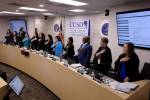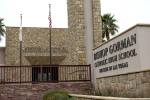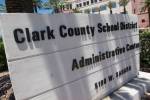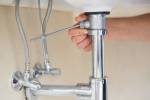91% + 87% + 88% = FAILED
Clark County School District students tested in January on their grasp of first semester material in high school algebra and geometry didn't just fall short of the mark.
The preliminary report on end of semester exams shows they missed it in a spectacular way.
Across the valley, 90.5 percent of 17,586 students who took the new end of semester exams for Algebra 1 failed, scoring at 59 percent or lower.
In Geometry, 87.8 percent of 18,792 students earned the equivalent of an F.
The 10,032 students in Algebra 2 also made a dismal showing, with 86.6 percent unable to achieve a passing grade.
The preliminary numbers jolted Superintendent Walt Rulffes, who said Wednesday that district staff are analyzing the test, its implementation and the scores to identify why students made such a poor showing.
"Maybe this is the shock we need to get the system fixed," Rulffes said.
The new exams aren't high-stakes tests: Failure won't result in punitive measures from either the state or the federal government.
The exams, created at the request of district leaders, are simply intended as an internal gauge of student mastery in those subjects.
The exams also were supposed to count for up to 20 percent of the semester grade for students.
Rulffes said the district is doing a second report to double check the preliminary findings.
Bill Hanlon, director of the Southern Nevada Regional Professional Development Center, worked with the district to create the exams with input from high school math teachers, who helped write multiple choice questions for the tests.
Practice exams were sent out to all the schools in August. Students took the test in January.
Hanlon expected the pass rates to be low because the tests are new.
As a veteran math instructor who now oversees a state-funded teacher training center, Hanlon knew that the rate of failure could come in at 30, 40 or maybe even 50 percent.
"I wasn't going to be happy about that," said Hanlon, a former member of the Nevada Board of Education. "In my wildest nightmare, I never would have thought that this would occur."
The shock of the low scores has administrators at all levels scrambling to account for what went wrong.
Complaints about test length and implementation have been made. The 44 to 50 multiple choice questions were too much for students to deal with in the allotted 120 minutes, some educators said. School officials also have been told that some teachers gave only part of the exam as a final or didn't use it at all.
There also might have been anomalies that affected individual campuses.
At Centennial High School, the majority of student test scores were left out of the preliminary report because of processing errors during grading. Of the 800 student test results at Centennial, Principal Trent Day said, only 170 were put into the system.
"We feel the test is not valid," Day said, adding that he also is hearing that district teachers administered the exams in different ways, with some allowing students to do it as a take-home test.
Other schools, such as Desert Pines High School, the College of Southern Nevada high schools, Laughlin High School and Global Community High School were omitted from the district's preliminary report on exam results.
For Hanlon, the most troubling possibility for the low scores on the exams, which was aligned to state standards, is that students aren't learning what they're supposed to because teachers aren't teaching the required curriculum.
"The bottom line is that kids typically don't do a good job when they aren't taught the material," Hanlon said. "Having failure doesn't bother me. That's part of having standards. But teachers have to teach the content they're assigned to teach."
Hanlon is all too aware of the challenges in doing that. Algebra and geometry class sizes in the district can exceed 40 students, Hanlon said. Those large groups span ability levels, from low performers to high achievers. Algebra is no longer a class just for the college-bound. All high school students take it.
In addition, Clark County is buffeted by the same critical shortage of math teachers that afflicts schools throughout the nation. As of this week, Clark County has 22 high school math vacancies staffed by long-term substitutes. There are another 503 full-time high school math teachers.
"It's not a good situation," Hanlon said.
The test results shocked Hanlon so badly he started meeting with district administrators and visiting schools. In doing so, he discovered a major problem. Some teachers weren't able to cover the required first-semester curriculum because they were spending time, at one school the entire first quarter, reviewing basic math skills with students.
"You just can't do that," Hanlon said.
Once a teacher falls behind like that, it's almost impossible to catch up, Hanlon said. Students end up being sent on to more advanced classes without mastering critical skills.
At Centennial, Day has tried to address that by creating pacing guides for teachers, so they're covering required materials in their classes. Centennial has also created math camps for students who need extra help.
"We are concerned about the achievement level of our kids," Day said.
Jhone Ebert, assistant superintendent of curriculum and professional development, said it's important to remember the initial results are raw data and this is the first time the test has been administered. Administrators are looking at the test question by question, to see where students have difficulty. They're also looking at why, because the test reflects course syllabi, there was such a range of performance in the school-to-school results.
The district also is looking at ways to provide more support to long-term substitute teachers in district classrooms, Ebert said.
"Do I wish the test scores were better? Absolutely," Ebert said. "But this is a starting point."
Contact reporter Lisa Kim Bach at lbach@reviewjournal.com or (702) 383-0287.
91%of Algebra 1 students failed the end-of-semester exam 87%of Algebra 2 students failed the end-of-semester exam 88%of Geometry students failed the end-of-semester exam See sample questions from practice exams below.RELATED STORY PRELIMINARY MATH TEST FAILURE RATES ON THE WEB Practice exams




























